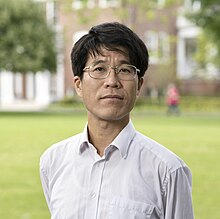Tadashi Tokieda (Japanese: 時枝正; born 1968) is a Japanese mathematician, working in mathematics and physics. He is a professor of mathematics at Stanford University; previously he was a fellow and Director of Studies of Mathematics at Trinity Hall, Cambridge. He is also very active in inventing, collecting, and studying toys that uniquely reveal and explore real-world surprises of mathematics and physics. In comparison with most mathematicians, he had an unusual path in life: he started as a painter, and then became a classical philologist, before switching to mathematics. Tokieda is considered a creative and fun person, giving excellent talks and explanations where he shows and teaches mathematical concepts in a simple, entertaining and beautiful way.
Tadashi Tokieda | |
|---|---|
 Tokieda in 2013 | |
| Born | 1968 (age 55–56) Tokyo, Japan |
| Education | Sophia University[2] University of Oxford Princeton University |
| Awards | Paul R. Halmos–Lester R. Ford Award (2014)[1] |
| Scientific career | |
| Fields | Mathematics |
| Institutions | Princeton University Cambridge University Stanford University |
| Thesis | Null Sets of Symplectic Capacity |
| Doctoral advisor | William Browder |
Life and career
editTokieda was born in Tokyo and initially intended to be a painter.[3] He then studied at Lycée Sainte-Marie Grand Lebrun[2] in France as a classical philologist. According to his personal homepage, he taught himself basic mathematics from Russian collections of problems.
He is a 1989 classics graduate from Sophia University[2] in Tokyo and has a 1991 bachelor's degree from Oxford in mathematics (where he studied as a British Council Fellow). He obtained his PhD at Princeton in 1996 under the supervision of William Browder.[4]
Tokieda joined the University of Illinois at Urbana Champaign as a J. L. Doob Research Assistant Professor for the 1997 academic year.[5]
He has been involved in the African Institute for Mathematical Sciences since its beginning in 2003.
In 2004, he was elected a Fellow of Trinity Hall, where he became the Director of Studies in Mathematics and the Stephan and Thomas Körner Fellow.[6][7]
He was the William and Flora Hewlett Foundation Fellow in 2013–2014 at the Radcliffe Institute for Advanced Study at Harvard University.[8]
In the academic year 2015–2016 he was the Poincaré Distinguished Visiting Professor at Stanford.[9]
Besides his native language Japanese, he is also fluent in French and English. In addition, he knows ancient Greek, Latin, classical Chinese, Finnish, Spanish, Russian as well as countless others.[10] When asked how many languages he knows, he answered "I don't really know. It's like asking how many friends you have."[11] So far he has lived in eight countries.[12]
In March 2020, Tokieda was interviewed on The Joy of X, Steven Strogatz's podcast for Quanta Magazine.[13]
Selected publications
edit- Tokieda, Tadashi (2013). "Roll Models". The American Mathematical Monthly. 120 (3): 265–282. doi:10.4169/amer.math.monthly.120.03.265. S2CID 38892886.
- Childress, Stephen; Spagnolie, Saverio E.; Tokieda, Tadashi (2011). "A bug on a raft: recoil locomotion in a viscous fluid". Journal of Fluid Mechanics. 669: 527–556. Bibcode:2011JFM...669..527C. doi:10.1017/S002211201000515X. S2CID 14039767.
- Montaldi, James; Tokieda, Tadashi (2003). "Openness of momentum maps and persistence of extremal relative equilibria". Topology. 42 (4): 833–844. arXiv:math/0201282. doi:10.1016/S0040-9383(02)00047-2. S2CID 8814996.
- Aref, Hassan; Newton, Paul K.; Stremler, Mark A.; Tokieda, Tadashi; Vainchtein, Dmitri L. (2003). "Vortex Crystals". Advances in Applied Mechanics. 39: 1–79. doi:10.1016/s0065-2156(02)39001-x. ISBN 9780120020393.
- Tokieda, Tadashi (2001). "Tourbillons dansants" [Dancing Swirls]. Comptes Rendus de l'Académie des Sciences, Série I. 333 (10): 943–946. doi:10.1016/S0764-4442(01)02162-0.
- Tokieda, Tadashi (1998). "Mechanical Ideas in Geometry". The American Mathematical Monthly. 105 (8): 697–703. doi:10.2307/2588986. JSTOR 2588986.
References
edit- ^ "Paul R. Halmos - Lester R. Ford Awards". Maa.org.
- ^ a b c 数学まなびはじめ 第3集 [Introduction to Mathematics Learning Volume 3] (in Japanese). Tōkyō: Nihon Hyōronsha. 23 July 2015. pp. 190–203. ISBN 978-4-535-78592-2.
- ^ Tokieda, Tadashi (July 11, 2022). "An Educated Adult". Numberphile (Interview). Interviewed by Brady Haran. California. Retrieved July 11, 2022.
- ^ "Tadashi Tokieda - The Mathematics Genealogy Project". University of North Dakota.
- ^ "Math Times - Fall 1997" (PDF). Illinois.edu.
- ^ "homepage". Trinity Hall, Cambridge. Archived from the original on 2016-06-05.
- ^ "Tadashi Tokieda's bio". Cam.ac.uk.
- ^ "Tadashi Tokieda". Harvard.edu. 25 September 2013.
- ^ "homepage". Stanford.edu.
- ^ "bio". "Modern Mathematics" International summer school for students.
- ^ Herzberg, Nathaniel (9 June 2023). "直感の逆を突き、驚かせ、人の未知への欲求を刺激する 仏紙が唸る「数学を世間に広める能力で、時枝正にかなう者はいない」" [He goes against intuition, surprises people, and stimulates their desire for the unknown. A French newspaper raves: "No one can match Tokieda Tadashi in his ability to popularize mathematics to the public."]. Courrier Japon (in Japanese). Retrieved October 21, 2024.
時枝はいったい何ヵ国語に通じているのだろうか。 「それは妻にしか打ち明けていない秘密というか、本当のところを言えば、よくわからないんです。言ってみれば、友達が何人いるのかを問われるようなものです。そんな質問は普通しませんよね」
[Just how many languages does Tokieda know? "It's a secret I only tell my wife, and to be honest, I don't really know. It's like asking how many friends you have. No one normally asks that question."] - ^ Stony Brook University (27 October 2016). "Five Questions With Tadashi Tokieda" – via YouTube.
- ^ "Tadashi Tokieda's Special Kind of Magic". Quanta Magazine. 10 March 2020. Retrieved 11 March 2020.
External links
edit- Tadashi Tokieda at the Mathematics Genealogy Project
- Personal Homepage at the Wayback Machine (archived September 19, 2018) at the University of Cambridge
- "Toy inspires new spin on Earth's magnetic field", New Scientist
- "Tadashi Tokieda on Numberphile playlist- YouTube". YouTube.